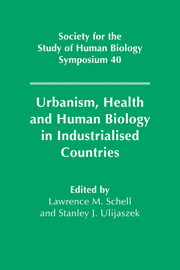Book contents
- Frontmatter
- Contents
- List of contributors
- Part I The urban environment
- Part II Epidemiology
- 5 Emerging infectious diseases: biology and behavior in the inner city
- 6 Fecundity and ovarian function in urban environments
- 7 Pollution and child health
- 8 Urbanism and health in industrialised Asia
- Part III Poverty and health
- Part IV Behavior and stress
- Part V The future
- Index
8 - Urbanism and health in industrialised Asia
Published online by Cambridge University Press: 06 January 2010
- Frontmatter
- Contents
- List of contributors
- Part I The urban environment
- Part II Epidemiology
- 5 Emerging infectious diseases: biology and behavior in the inner city
- 6 Fecundity and ovarian function in urban environments
- 7 Pollution and child health
- 8 Urbanism and health in industrialised Asia
- Part III Poverty and health
- Part IV Behavior and stress
- Part V The future
- Index
Summary
Editors' introduction
Southeastern Asia is currently urbanising at a faster rate than any other major geographical region, and four of the ten largest cities in the world are now to be found there. In examining the complexity of factors which have lead to changing patterns of urban health in Asian cities, Peters develops themes that are resonant with those of other authors in this volume, including McMichael (chapter 2), Clark (chapter 3), Di Ferdinando (chapter 5), Schell and Stark (chapter 7), and Parker (chapter 14). Overlapping environments graded by social, economic, cultural, and ethnic factors are implicit in descriptions of unemployment, social instability and insecurity, undernutrition, and infectious disease sitting in close proximity to the emerging middle classes who are now experiencing rising levels of obesity and diseases of affluence. Although this description could equally apply to many cities of the industrialised West, there are some differences between Asia and Europe and the United States. Unlike Johnston and Gordon-Larsen (chapter 10), Peters describes obesity as a problem of the Asian middle classes, and not of the poor. Furthermore, exposure to pollution is perhaps greater than among the North American populations described by Schell and Stark (chapter 7), and Czerwinski (chapter 11).
- Type
- Chapter
- Information
- Urbanism, Health and Human Biology in Industrialised Countries , pp. 158 - 172Publisher: Cambridge University PressPrint publication year: 1999
- 1
- Cited by



